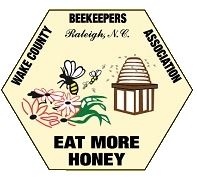 | Wake County Beekeepers Association |
Beekeeping Calendar
September
| The Bees |
The hive population is dropping. The queen’s egg laying is significantly reduced, and the drones may begin to disappear this month. |
| The Beekeeper |
It’s time to do that rare, final harvest for the season. Remember to leave at least 40 pounds of honey for the hive to get through the winter. Attend your bee club meetings |
| Inspections |
Continue to check on queen performance. Watch for excessive hive beetle populations Watch for wax moth signs |
| Queen health, laying |
Queen failure this month or later may require combining colonies. |
| Nutrition |
Goldenrod 8/1 – 10/15; Coreopsis; Asters, 9/20 – 10/30. Fall nectar flow may take place Remember to leave at least 40 pounds of honey for the hive to get through the winter. Keep water available constantly Feeding continues until the bees will take no more syrup. Feed 2 to 1 sugar water Some large colonies will gain weight from fall nectar, but cannot be relied upon to build weight for winter. Check those that had good honey stores to ensure they didn’t burn through it. |
| Pests |
Varroa treatments should be complete by the end of the month Alternating medications to keep pests from developing immunity to them. All medications will vary in monthly usage. Watch for excessive hive beetle populations Watch for wax moth signs |
| Management |
Remove queen excluders. Reduce entrances and mouse guards Combine weak hive with a stronger one – take winter losses now. Ensure adequate ventilation as weather cools Right size equipment to match bee population |
| Swarms |
Lower chance of swarming thru the end of the year |
| Products of the Hive |
In some circumstances, fall honey harvest is possible, but care must be taken to avoid using supers during feeding to ensure all the honey is from nectar and none is from syrup. Remember to leave at least 40 pounds of honey. Melt down wax from cappings or crushed comb and culled frames. |
Return to the Beekeeping Calendar
